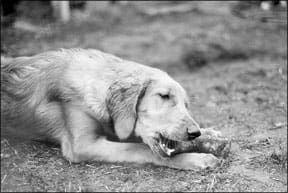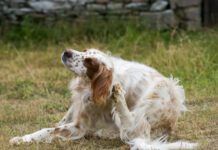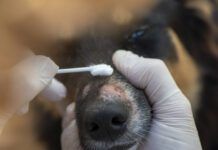Anorexia, bulimia, and weird pregnancy cravings are common in humans, but did you know dogs have eating disorders, too? Dogs with pica (pronounced PIE-kuh) consume indigestible nonfood items like rocks, concrete, wrought iron, glass, ice, coins, screws, upholstery stuffing, batteries, soda cans, gravel, dirt, clay, and other objects. Young puppies often chew on inappropriate items in an effort to ease the discomfort of teething; this is different. Adolescent and adult dogs who exhibit pica compulsively chew and consume inappropriate items, sometimes resulting in their deaths.
Chewing hard or sharp objects can damage teeth, gums, or digestive organs. Objects that become stuck or cause blockage can require surgery. And items containing zinc or other toxic minerals can poison the dog.

288
Dog owners more frequently complain about another disturbing habit of canine consumption: coprophagia (pronounced cop-ra-FAY-jee-a) or “dung eating.” Though dogs with coprophagia may eat only deer droppings, cat box contents, horse manure and the like, people are most horrified (and frustrated) with dogs who eat their own or other dogs’ stools. Bleh!
What causes these canine eating disorders, and what can be done about them?
Most veterinarians consider pica and coprophagia behavioral problems having nothing to do with nutrition because their patients are fed a 100-percent nutritionally complete canned or packaged dog food.
But while it’s true that you are what you eat, it’s even more true that you are what you absorb, and not every dog has a perfect digestive tract. In many cases, improving a dog’s diet and/or digestion has resulted in significant behavior changes. In addition to using positive reinforcement to encourage dogs to consume appropriate food items and leave other things alone, a few simple adjustments to the dog’s daily fare may solve the problem.
A closer look at pica
When pica is caused by a nutritional deficiency or imbalance, other symptoms accompany the condition. In the May 1996 Journal of the American Holistic Veterinary Medical Association, Martin Schulman, VMD, reported that mineral deficiencies often contribute to the development of seizures.
In a review of the medical histories of patients diagnosed with epilepsy in his clinic, Dr. Schulman discovered that an “astonishingly high percentage” showed significant manifestations of pica. In one case, a female German Shepherd Dog had a history of licking wrought iron and eating Christmas tree lights and glass. Treating the patient with an improved diet supplemented with plant-derived colloidal minerals, digestive enzymes, and probiotic foods cured the pica within 21 days, and the dog had no additional seizures.
Other conditions that can coincide with pica include hair loss, dry or flaky skin or coat, pigment problems, infertility, eclampsia or other problems with pregnancy or whelping, birth defects, bone and growth problems, anemia, fatigue, muscle spasms, irregular heartbeat, respiratory illnesses, allergies, digestive disorders, immune system problems, slow wound healing, glandular disorders, and chronic ill health.
Advocates of home-prepared diets often claim that a well-balanced raw diet eliminates or prevents pica, but occasionally the condition occurs even in well-fed dogs.
In Riverside, California, Jacki Panzik has been breeding Standard Poodles for 15 years, feeding a raw diet and using minimal vaccinations. She recently dealt with two litters born within a month of each other that were sired by the same stud dog, in which the puppies at age 12 to 16 weeks showed symptoms of pica, including the consumption of dirt.
“Pica is often demonstrated in autistic children,” she says. “I am in the field of alternative medicine, and I see a lot of similarities between the physical condition of some dogs today and autistic children.”
Panzik and her husband do energy balancing, so they worked with the pups and their sire energetically to correct the problem’s underlying causes. In addition, they suggested adding bone meal to the diet fed to the pups. Within a week, the puppies from both litters stopped eating dirt.
Wendy Volhard, author of the bestselling Holistic Guide for a Healthy Dog, has observed symptoms of pica in dogs who have a tendency to bloat. “When they are outside and a bloating episode is about to start,” she says, “you sometimes find them eating grass, leaves, and dirt without stopping. If confined indoors, they may eat the fringes of carpets, curtains, and whatever else they can reach. This is true aberrant eating behavior, and in every case I have observed, the result has been bloat.”
Years ago, Volhard’s Briard, DJ, was with her at a training camp, and when she returned to her room after teaching a class, she was horrified to find DJ pulling curtains through the top of his wire crate. He had swallowed more than half of one before she could get him out and untangle the mess.
DJ was the portrait of a dog going into bloat as he stood panting with his head down and his left side brick-hard and slightly protruding. Volhard treated him homeopathically and did acupressure on his stomach meridian while someone drove them to the nearest veterinarian. The examination and x-rays showed that DJ had suffered no damage, but he went on to experience several more episodes, including one in which he ate large quantities of autumn leaves.
“We went back and forth to the vet many times,” says Volhard, “and each time he was okay. Taking care of it is one thing, but I wanted to stop it entirely. I discovered that dogs with this condition seem to respond very well to the addition of hydrochloric acid and pepsin at every meal.
“This made me think that they don’t have the capacity to make enough stomach acid to break down their food. In my experience, adding this simple supplement has been very successful in stopping pica. In DJ’s case, a hydrochloric acid and pepsin capsule twice a day in his meals, plus a spleen glandular supplement during the change of seasons, did the trick. It took some trial and error but he never again had a problem with bloat or showed any symptoms of pica.”
Stool eating
In the wild, dung eating is common. As L. David Mech, Ph.D., explained in “What a Wolf Eats” (WDJ March 2005), wolves are opportunistic omnivores. “They will eat literally anything that is remotely edible,” he says. The same is true of all canines. In his popular book Give Your Dog a Bone, Australian veterinarian Ian Billinghurst reminds readers that all dogs are scavengers.

Jacki Panzik
278
“They receive valuable nutrients from material we humans find totally repugnant,” Billinghurst says, “things like vomit, feces, and decaying flesh . . . Feces are a highly valuable food consisting of the dead and living bodies of millions upon millions of bacteria. To replace feces requires a team of ingredients like yogurt, brewer’s yeast, eggs, oils, an enzyme product, and crushed raw vegetables as a source of fiber.”
Mother wolves, like mother dogs, ingest the fecal matter produced by their young puppies. Some researchers say this is an attempt to hide the litter from predators, while others say it provides the mother with nutrients.
Both theories are probably correct. The manure of herbivores such as deer, elk, cattle, sheep, geese, and other grass-eating animals contains B-complex vitamins, vitamin K, minerals, beneficial bacteria, essential fatty acids, enzymes, antioxidants, and fiber. Although most dogs who indulge remain healthy, veterinarians warn that fecal matter may contain parasites such as giardia, coccidia, roundworms, or whipworms.
Some dogs become interested in their own stools only after they eat raw carrots or other foods that they cannot completely digest. Withholding hard-to-digest foods from your dog’s diet is a simple solution.
Because grain-based foods are difficult for dogs to digest, a high-carbohydrate dog food can cause a dog to produce large amounts of feces containing only partially digested ingredients. Feeding a grain-free food or home-prepared food that is high in protein and low in carbohydrates can result in more complete digestion and smaller, less appetizing stools.
Those who feed raw bones report that the end result of a meal that includes raw bone is small, hard, dry, and less interesting than fecal matter that does not contain bone.
In her Complete Herbal Handbook for the Dog and Cat, Juliette de Bairacli Levy (see “Grandmother Nature,” July 2006) writes, “Dogs should never have their natural instincts thwarted in the matter of diet. They should not be prevented from eating the droppings of grass-fed cattle and horses, from which they can get many vital elements derived from the herbage on which the animals have grazed and in a form easily assimilated by the dog . . . Only eating its own or other dogs’ feces is a depraved habit and should be checked at once.”
Commercial products with names like For-Bid, Deter, and SEP (Stop Eating Poop) are designed to make stools unappetizing. For-Bid contains wheat gluten and monosodium glutamate, which are said to work with the digestive tract to give stools a bad taste. Deter tablets contain a “natural vegetable extract.” SEP (Stop Eating Poop) powder contains dicalcium phosphate, rice flour, glutamic acid, peppermint, Yucca schidigera extract, beef liver, oil of parsley, and natural flavoring.
Do-it-yourself treatments include sprinkling monosodium glutamate (MSG, or Accent flavor enhancer) on the dog’s food, adding a drop of anise essential oil, or adding garlic, pumpkin, meat tenderizer, pineapple, zucchini, or Fig Newtons to the food. By all accounts, these methods work for some dogs but not for all.
“I’ve never had much success breaking a dog of this habit,” says canine health researcher Mary Straus, who lives in the San Francisco Bay area. “Interestingly, it’s a habit that can be learned as an adult, not just as a puppy. My Nattie was a stool-eater, but Piglet never was until she started observing Nattie. She’s now as bad as Nattie ever was.”
While debate continues as to whether coprophagia is a behavioral problem, there’s no doubt that dogs who are bored, receive little aerobic exercise or interesting play, and have unlimited access to their own or other animals’ droppings will be difficult to discourage. Increasing the dog’s active exercise, giving him a larger assortment of interesting toys to play with, keeping the dog’s exercise area clean and free from excrement, keeping cat litter boxes out of reach, and giving the dog several small meals per day rather than only one large meal can all help reduce his interest in coprophagia or at least reduce his opportunity to indulge.
Improve your dog’s digestion
In addition to improving your dog’s diet, start using supplements that can improve her digestion.
For example, try an enzyme product like Prozyme. The heat of processing destroys enzymes in food, making the food more difficult to digest. Enzyme powders sprinkled on food supply these important catalysts, resulting in more efficient digestion. Many vets and dog owners have reported excellent results from adding Prozyme or similar enzyme powders to the food of dogs with pica or coprophagia.

278
Digestive support products that contain hydrochloric acid, pepsin, and other digestive enzymes may help prevent pica and bloat in dogs whose hydrochloric acid production is low.
Human digestive supplements that contain hydrochloric acid (HCl) and pepsin or other digestive enzymes can be adapted for canine use. Assume that the human dose is appropriate for someone weighing 120 to 150 pounds and divide this amount by your dog’s weight to adjust the recommended dosage. Add one capsule or tablet (or an appropriate fraction of a capsule or tablet), buried in food, at the end of the meal. If feeding a dry dog food, wrap the tablet or capsule in a piece of cheese, a piece of meat, or something the dog will swallow whole.
Digestive supplements that contain warming herbs or spices such as ginger or cinnamon can also help improve digestion and assimilation. As above, adjust the dose for your dog’s size, or simply sprinkle 1/8 to ¼ teaspoon powdered cinnamon or ginger on your dog’s food. Give smaller amounts to small dogs and larger amounts to giant breeds.
Seacure is a fermented deep sea white fish product sold as pet supplement powder, chewable wafers, and capsules. Because it is predigested, its amino acids and peptides are immediately assimilated, facilitating tissue repair throughout the body. Dogs with digestive disorders that contribute to pica often improve quickly, and those with coprophagia may become less interested in their fecal output.
Dee Eckert, at Seacure’s manufacturer, Proper Nutrition, Inc., says they have heard from breeders, trainers, and pet guardians who say that Seacure helped eliminate symptoms in dogs with pica and coprophagia. “We have been told that dogs who exhibit these behaviors suffer from leaky gut syndrome and malabsorption. If this is true, it makes sense that Seacure would help because it is best known for treating digestive and malabsorption issues.” (For more information, see “Securing Seacure,” April 2003.)
Beneficial bacteria play an important role in not only the digestion process but the entire immune system. In fact, beneficial bacteria are the body’s first line of defense against harmful bacteria, viruses, parasites, and other pathogens. (See “Probing Probiotics,” August 2006, for more information.)
Lactobacillus acidophilus and other species of beneficial bacteria help prevent diarrhea, leaky gut syndrome, lactose intolerance, and other symptoms of indigestion. They assist in the production of vitamins and enzymes, decrease toxins and mutagenic reactions, improve the assimilation and utilization of carbohydrates and protein, and strengthen the body’s ability to fight infection.
But many American dogs have insufficient quantities of beneficial bacteria. One reason is their frequent treatment with antibiotics, which kill good as well as bad bacteria. Another is processed pet foods that disrupt the body’s ecology and help harmful strains of bacteria take over.
Adding beneficial bacteria in the form of live-culture yogurt or probiotic supplements helps restore the body’s army of friendly microbes. Probiotics are recommended for all dogs with pica, coprophagia, or digestive disorders.
Mineral supplements are another recommendation for dogs with eating disorders. Humans with iron-deficiency anemia often crave ice or paper, while those with other mineral deficiencies may crave items like laundry starch, chalk, clay, dirt, or charcoal from a wood stove. Mineral deficiencies may trigger similar cravings in dogs, and numerous holistic veterinarians report resolution of their patients’ pica eating with mineral supplementation.
Several brands of colloidal minerals are sold in health food stores, most of which contain more than 60 minerals and trace elements. Mineral supplements like the Standard Process product Min-Tran, which is available from veterinarians and some online retailers, have helped many dogs recover from pica.
Adding vegetable oil to the dog’s food has helped in some cases of pica and coprophagia. Coconut oil may be the best vegetable oil for dogs because of its stability and its ability to destroy harmful bacteria, viruses, parasites, yeasts, and fungi. Coconut oil helps repair digestion and improves the assimilation of nutrients. Add coconut oil to any dog’s food at the rate of 1 teaspoon per 10 pounds of body weight, starting with smaller amounts and building up gradually. (For more information, see “Crazy about Coconut Oil,” October 2005.)
Other methods
Homeopathy has helped some dogs with pica or coprophagia. In classical homeopathy, remedies are prescribed individually according to each patient’s history and symptoms. For best results, consult a veterinary homeopath.
Acupressure, acupuncture, and herbs have also helped. In her book Four Paws, Five Directions: A Guide to Chinese Medicine for Cats and Dogs, Cheryl Schwartz, DVM, describes excessive appetite and the eating of strange things as symptoms of “excessive stomach fire” associated with the liver and gall bladder.
Dr. Schwartz explains how to treat the problem by holding key acupuncture points. She also recommends 2 to 3 dropperfuls each of dandelion (Taraxacum officinale), burdock (Arctium lappa), and wood betony (Betonica officinalis) tinctures for medium and large dogs, twice daily, plus 2 to 3 teaspoons of strongly brewed chamomile (Matricaria chamomilla) tea twice daily with food. Small dogs receive 1 dropperful of each tincture and 1 teaspoon chamomile tea.
Some people have successfully trained their dogs to stop eating fecal matter, rocks, and other objects using various methods at least, as long as they were present and vigilant. In general, though, most owners have learned that managing the dog’s habit by simply keeping him away from the forbidden treats will be more fruitful, and less frustrating, than positive or negative training methods. And the various health-based strategies described above provide more reliable results.
There may be no simple cure for pica or coprophagia, but the potential for relief from these disturbing habits makes trying a few of these treatments definitely worth the effort.
A long-time contributor to WDJ and author of The Encyclopedia of Natural Pet Care, Natural Remedies for Dogs and Cats, and other books, CJ Puotinen lives in New York with her husband, a Lab, and a tabby cat.






